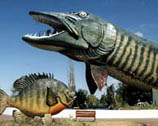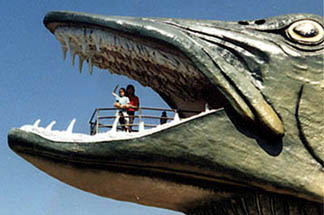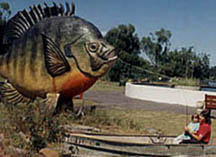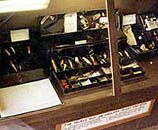WHERE LEGENDS COME
TO LIFE
The National Fresh Water Fishing Hall of Fame
by
D. James Tindell
(originally published in Trail
Blazer, 2003)
It rises above the skyline, gigantic maw lined
with fearsome incisors, eyes the size of tractor tires searching
for its next meal, and for a brief moment, reality becomes fantasy
and the observer thinks that maybe this is real, like a creature
from a Japanese sci-fi movie that has come to northern Wisconsin
to munch on us. One imagines there must be a sign that says,
"Do not disturb the big fish, for you are crunchy and good
with ketchup."
It's Hayward's largest and most famous resident, the Big Musky,
and it's really pretty friendly. It doesn't munch on people;
in fact, it will gladly take you into its mouth to give you a
view of the town from four stories up, and some folks have even
gotten married there. Officially it's known as the "Shrine
to Anglers", and at 143 feet long it is quite likely the
world's largest fiberglass structure. When you see the big fellow,
you know you're near the National Fresh Water Fishing Hall of
Fame.
The Hall had actually been in operation for more than a decade
when someone decided it should have a big fish outside. "That's
exactly what happened," says Executive Director Ted Dzialo.
One of the Hall's founders had seen a large fiberglass walleye
at some now-forgotten location and figured a musky would be an
appropriate choice for Hayward. A firm in Sparta was found that
could build such a thing, and in the late summer of 1978 the
Big Musky was officially dedicated. In the spring of '79 the
half-million-dollar fish was opened to the public.
The Musky is actually one of several fiberglass fish that decorate
the grounds of the Hall, representing different species. More
reproductions, on a life-sized scale, are found indoors, and
even these fish are so large that the visitor wonders if lunkers
like that really did exist. That's when the stories begin to
flow, and there are many of them, for what would a Fishing Hall
of Fame be without stories?
The overall story began in 1960, when a group of Hayward businessmen
got together to start a Fishing Hall of Fame. "They were
in the fishing game or the tourism game, or connected to businesses
in town that were connected to tourism," Dzialo says, "so
they felt it would be a perfect spot for a Hall of Fame."
The goal was to create a repository for the sport's artifacts
and legends, and of course to lure people to town to see it.
(Please excuse any fishing-related puns.)
Bob and Fannie Kutz of Hayward were the prime movers behind the
initial concept, but it took some years for their dreams to start
taking shape. The five businessmen who came aboard were Erwin
Gerlach, H.R. (Bud) Nelson, Oscar Treland, Quentin Johnson and
Walter West. The group secured recognition as a non-profit organization
in 1970, and the hunt for funding kicked into high gear.
When efforts to secure government funding came up empty, the
founders decided to approach corporations with connections to
the fishing industry. Their goal was to raise a million dollars.
Individual donors began to come forward, but the first corporate
sponsor came from outside the fishing industry. It was, however,
one which had long associated itself with men and the outdoors:
the Jim Beam whiskey distillers of Chicago and Kentucky. Beam
offered to give the Hall a percentage of the sale of fish-themed
whiskey decanters, a program which would generate some $300,000
over the ten-year life of the project. The decanters quickly
attracted nationwide attention and the resultant publicity generated
even more donations from the public.
By the mid-1970s, the Hall had come to life on six acres of land
donated by the City of Hayward. The gateway building, housing
the Hall's offices and temporary museum displays, opened in 1976.
Some 8,000 visitors came through the doors during the inaugural
season, paying fifty cents apiece. A year later, attendance increased
by fifty percent and the Hall began its membership program, attracting
some 1,500 supporting members who paid dues of $10 each.
Things started happening pretty quickly after that. The Big Musky,
along with a much smaller but still impressive Walleye, were
erected as the first residents of the newly landscaped grounds'
"Sea of Fishes". Memorial gardens were dedicated to
recognize benefactors of the Hall. By 1984, three additional
wings had been built to house the Hall's growing number of artifacts
and the Hall's attendance had risen to nearly 100,000 visitors.
The "Sea of Fishes" now included a Bluegill, Coho Salmon,
Rainbow Trout and Smallmouth Bass. Eventually a Largemouth Bass
would be added, and in the mid-1990s another building was erected
to serve as the location for the Hall's extensive collection
of vintage boats and motors.
Like many museums, there's so much to see that the visitor must
plan to spend at least a few hours. For those who are particularly
interested in the history and types of fishing lures, the Hall
has more than 5,000 of them. There are hundreds of rods and reels,
more than 300 classic marine engines, and some 400 replicas of
record-breaking fish of about 200 species.
A visitor's attention is drawn to the display of outboard motors,
including some of the first ones made by the inventor of the
outboard, Ole Evinrude himself, in the early years of the 20th
Century. Dzialo relates the story of what inspired Evinrude to
make his first motor. One day Ole and his wife went out on a
lake in a rowboat, Dzialo says, "and his wife wanted some
ice cream, and before he could bring it out by rowing, the ice
cream had melted. He figured there's got to be a better way to
do this." Among the long racks of outboards, the visitor
sees a 1958 Scott-Atwater, just about like the one his father
had, bringing up memories of pleasant days on the Mississippi,
fishing for bluegill and catfish. Indeed, it's impossible to
go through the Hall without saying things like "My father
had one just like this," or "Grampa taught me how to
fish with one of these."
The Hall of Fame is much more than a museum, though. It really
is a Hall dedicated to the recognition of fishermen---and women.
The Hall Awards Committee takes nominations from the public and
meets each January to select inductees for Enshrinement, Legendary
Angler, Legendary Communicator, Legendary Guide, Organizational/Governmental
Entity, and Special Recognition. Although there are specific
guidelines to follow, anyone can submit a nomination. "All
they've got to do is give us a call or drop us a note,"
Dzialo says. Among the nominees elected for 2003 is Larry Ramsell
in the category of Legendary Angler. A skilled musky fisherman
who has landed many trophy fish all over North America, Ramsell
developed the World Records Program at the Hall, and serves as
its fish historian and records advisor.
Ramsell's work has not only led to his induction into the Hall
of Fame, he has helped the Hall become the repository of fresh
water fishing's official record book, covering more than 125
species. Records are kept for every state in the Union and many
foreign countries, and are subdivided into categories that cover
rod and reel fishing, fly fishing, pole/line/no reel, and even
by different weights of line within each category. Instructions
for qualifying a catch as a potential record-breaker are meticulously
detailed. And the records are impressive. One learns, for example,
that the biggest fresh water fish ever taken in Wisconsin was
a 195-pound lake sturgeon that was landed (presumably after a
mighty struggle) by Henry St. Germain on Pokegama Lake in 1979.
Even that lunker doesn't measure up to the 800-pound white sturgeon
that was somehow caught by Harold Hiltz on the Fraser River in
British Columbia in 1972.
The foreign-catch section of the record book lists several exotic
species, like the African tigerfish (a 20-pounder caught in 2001
in Zambia holds the record) and the morocoto pacu (36-pounder,
Bolivia, 1999). The world record for piranha, by the way, is
6 pounds 8 ounces, caught by one David Ormdorf in 1982 on the
Matevini River in Colombia. The book does not say whether Ormdorf
survived the encounter.
Concerned about the conservation of fish species, the Hall began
the Catch and Release program in 1993, which quickly caught on.
Records are kept in this category, too, but by length, not weight,
so as not to overly stress the fish before its release. The record?
A 114-inch white sturgeon hauled out of the Snake River in Idaho
in 1993. That's nine and a half feet long, sports fans.
The Hall of Fame is open every day from April 15-November 1,
from 10am-5pm. For more information, call 634-4440 or email to
fishhall@cheqnet.net.
The Hall's official website is at www.freshwater-fishing.org.
Its location? Just go to Hayward and look for the Big Musky.

Special thanks to D.
James Tindell,
Trailblazer Magazine,
and the
National Freshwater
Fishing Hall of Fame
for making the story available to us.
|

Hello!

There are many fiberglass fish to see.

Boy! Fishing for BIG fish sure is a lot of work!

A floor display case featuring
antique lures in an old tackle box

A wall display featuring old pictures
and newspaper articles

There is a
small park
where kids can
swing or ride
on fishes
|





